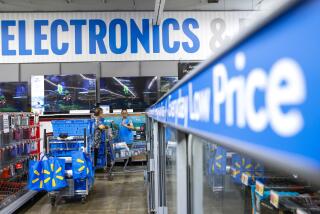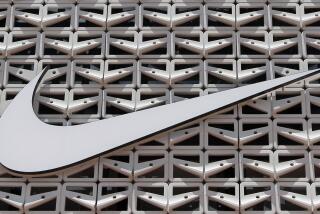Teen apparel retailers suffer as consumers get stingier
- Share via
Teen apparel brands have been losing their shirts, and it’s not a fashion choice.
Against a backdrop of prolonged consumer stinginess, reinforced Friday by reports of a scant monthly increase in August retail sales, an anemic back-to-school performance may herald more economic sluggishness to come.
“The economy, employment, wages and retail sales continue to stagger along,” said Matthew Shay, chief executive of the National Retail Federation. “While positive retail sales growth continues month after month, it is just not strong enough to move the needle.”
Although some market indicators seem to be improving — housing prices and sales are up, as are stocks — consumer confidence is tumbling, according to a measure Friday from the University of Michigan and Thomson Reuters.
The same day, the Commerce Department said that total retail and food services sales increased a tepid 0.2% in August from July. Sales at clothing and accessories stores slipped 0.8% from July.
Although the overall gauge is up 4.7% year over year, analysts say the performance is disappointing.
“This is not good news for retail buying this autumn, and there might be no change in these conditions right into the holiday season — a projection likely to dampen spirits in the retail sector,” said Kathy Bostjancic, director of macroeconomic analysis at the Conference Board.
Teen brands such as Abercrombie & Fitch Co., American Eagle Outfitters Inc. and Aeropostale Inc. are staggering out of the shaky back-to-school season shunned by jobless youth and their cash-strapped parents, pummeled by unseasonably cold weather and perplexed by hazy fashion trends.
Same-store sales for all three companies slid in their most recent quarters. Since the beginning of the year, the trio’s stock prices have suffered double-digit slides. Many brands have issued dire financial warnings for the remainder of 2013.
“Teen retail is a very competitive and difficult sub-sector to begin with — you’re dealing with a fickle customer base, fashion trends are always changing,” said Howard Tubin, an analyst with RBC Capital Markets. “But in the second quarter, things took a turn for the worse and business fell off. It’s doing very badly.”
Some on Wall Street say the drop-off is an indicator of general economic malaise compounded by the disproportionate effect on young people of the recession and its aftermath.
The jobless rate for people ages 16 to 19 was 22.7% in August, compared with 7.4% for the population as a whole, according to the federal government. Only a third or so of the demographic is employed or wants to be — a record low.
Teen hiring this summer got off to its strongest start in seven years but closed 3% below last year’s levels, according to outplacement firm Challenger, Gray & Christmas Inc. Many employers gave jobs typically filled by high school students to “older, more experienced job seekers, such as recent college graduates and recent retirees,” the group found.
And many parents aren’t in a position to chip in money for their teens to go shopping at the mall. The payroll tax hike this year, coupled with rising gas prices in California, caused consumer spending to slow more than expected.
“Aside from autos, consumers were hesitant to loosen their purse strings, cutting back on nonessential, discretionary purchases,” Sterne Agee Chief Economist Lindsey M. Piegza said in a note to clients. “With income growth of less than 1% and waning momentum in the jobs market, consumption is likely to falter further.”
Some experts, however, think the sudden drop-off in sales at teen retailers this summer has less to do with larger economic forces than with changes in taste.
And although 2012 was the year of color, featuring bold prints, bright pants and neon accessories, this summer has been devoid of a “large, accessible, easily understood fashion trend,” Tubin said. Teen retailers have resorted to a scattershot strategy in choosing trends to feature.
Many are also behind the times, offering clothing geared to a casual, laid-back lifestyle that’s losing cachet among increasingly put-together teens, said NPD analyst Marshal Cohen. Young shoppers are dressing like adults earlier in their lives, fueling the rise of affordable and trendy fast fashion outlets such as H&M and Forever 21.
Some teen retailers have adapted. The Buckle enjoyed a 1% same-store sales gain in August, while the gauge at Zumiez increased 3%, both beating Wall Street expectations.
But many in the field continue to lag. Billabong International Inc. reported its most dismal earnings on record last month and wrote down the value of its namesake brand to zero. Southland firms Quiksilver Inc. and Pacific Sunwear of California Inc. said their losses widened in their latest quarters.
“Not everything that worked for the last decade is going to work for this crop of teens,” Cohen said. “There was so much interest garnered for the latest iPhone release that it makes us realize that other things have out-fashioned fashion.”
Recent controversies from the likes of Abercrombie haven’t helped. In May, 7-year-old comments from Chief Executive Michael S. Jeffries about the exclusive nature of the brand resurfaced and sparked outrage and a Change.org petition. This week, a federal judge in San Francisco ruled that the company wrongly fired a Muslim worker who refused to remove her head scarf.
Consumer sentiment toward Abercrombie slumped this summer to its lowest point in at least six years, according to a YouGov BrandIndex gauge. American Eagle, though better received than its rival, did the same.
Several companies have lowered their projections for the all-important holiday season.
They’ve already lost UC Riverside engineering student Tiffany Ting, 20, who gets less pocket change from her parents and prefers bargain-hunting online for more mature clothing from the likes of Nordstrom.
“With the economy the way it is now, everything seems overpriced for what it’s actually worth,” she said. “Shopping is not really a priority.”
Ting said she still buys jeans at American Eagle but finds the rest of the logo-heavy clothing “almost childish.”
“I feel like I’m past that,” she said.
Twitter: @tiffhsulatimes
Times staff writer Jim Puzzanghera contributed to this report.
More to Read
Inside the business of entertainment
The Wide Shot brings you news, analysis and insights on everything from streaming wars to production — and what it all means for the future.
You may occasionally receive promotional content from the Los Angeles Times.











